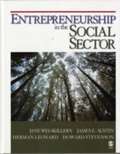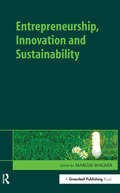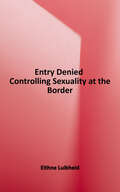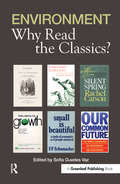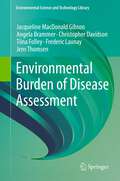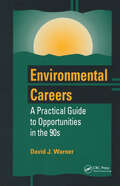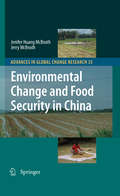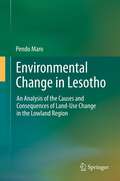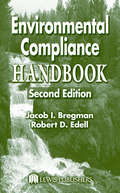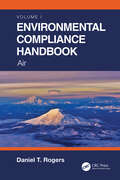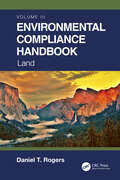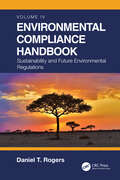- Table View
- List View
Entrepreneurship in the Social Sector
by Howard Stevenson James E. Austin Jane Wei-Skillern Herman LeonardWritten for students and practitioners of social entrepreneurship, Entrepreneurship in the Social Sector is about the opportunity and challenge of applying leadership skills and entrepreneurial talents creatively and appropriately to create social value. This book spans a range of social enterprise activity, using international examples from nonprofit-making to social purpose for-profits settings, with a primary focus on the social entrepreneurial process itself. This casebook is designed to develop knowledge and skills for creating, leading, or supporting social purpose organizations and to achieving maximum impact through social entrepreneurship.
Entrepreneurship, Finance, Governance and Ethics
by Douglas Cumming Chris Mallin Robert CressyThis book covers topics that are at the intersection of business ethics and governance as they pertain to entrepreneurship and finance. It is the first focused work that links entrepreneurship and finance to governance and business ethics, rather than explore them separately. The chapters highlight with empirical data the strong interplay between ethics in organizational efficiency and financial activity, and the role of legal settings and governance in facilitating ethical standards. They discuss novel and timely topics, particularly given the recent financial crisis and discussions on regulating ethical behaviour. This book will encourage future scholars to investigate the role of law and governance in mitigating corruption and facilitating integrity in entrepreneurship and finance.
Entrepreneurship, Innovation and Sustainability
by Marcus WagnerThis book addresses the intersection of entrepreneurship, innovation and sustainability (EIS), presenting high-quality research illuminating the relationship between the three fields. The EIS nexus is particularly relevant from a European point of view given the focus of the European Commission on corporate social responsibility (CSR) and sustainability, as well as their prominent role within the European Union in general. Also, the rapid economic growth witnessed especially in the BRIC countries in recent years requires that firms reconcile sustainability aspects with profitability and innovation, and entrepreneurs are seen as key diffusers of these aims. Sustainability requires both radical and incremental innovation at many different levels (technology, product, process, system). In many cases, such innovations come from small and medium-sized enterprises and so the role of the entrepreneur is key to their success. The book is split into six sections. The first section examines the nexus in detail focusing on system-oriented connectivity between sustainability, innovation and entrepreneurship. The second section looks at how to nurture corporate entrepreneurship for sustainability; and the third considers "mature" industries such as automotives, chemicals and electronics and how sustainability aspects can be integrated into innovation process and strategy. The fourth section examines the nexus through the lens of developing countries in Africa. Sustainable entrepreneurship is identified as a hugely beneficial way to foster development. The fifth section of the book concentrates on SMEs; and finally the EIS nexus is approached from a network perspective and focuses on inter-organisational partnerships, which are often an important facilitator or spark for EIS initiatives.This book will prove to be essential for researchers in the EIS nexus and be of invaluable help to practitioners, governments and inter-governmental bodies attempting to encourage sustainable entrepreneurship and innovation.
Entrepreneurship, Innovation and Sustainable Growth: Opportunities and Challenges
by Nader H. Asgary Emerson A. MaccariEntrepreneurship and innovation play a vital role in fostering sustainable development. Advances in technology and communications have both transformed the process of business as well as strengthened the role of entrepreneurship in developed and developing countries. This important book is the first to provide the fundamental concepts and applications for faculty and students in this field, and also serves as a professional reference for practicing entrepreneurs and policymakers. Each chapter provides a clear guide to the conceptual and practical elements that characterize entrepreneurship and the process of new venture formation, including functional strategies in key areas such as marketing, information technology, human resources management, and accounting and finance. Questions and exercises are presented throughout in order to encourage discussion and problem-solving. A quick summary of the important concepts and definitions are also provided. Keeping practicality as the book’s core aim, all chapters include a long case study to set the scene and then draw upon shorter cases from both developing and developed countries to reinforce key learning objectives and the real-world application of the book’s core concepts.
Entrepreneurship, Innovation, and Sustainable Growth: Theory, Policy, and Practice
by Nader H. Asgary Emerson A. Maccari Heloisa C. Hollnagel Ricardo L.P. BuenoEntrepreneurship and innovation play a vital role in fostering sustainable development. Advances in technology and communications have both transformed the process of business and strengthened the role of entrepreneurship in developed and developing countries. This new edition of Entrepreneurship, Innovation, and Sustainable Growth provides the fundamental concepts and applications for faculty and students in this field, and also serves as a professional reference for practicing entrepreneurs and policymakers. Each chapter provides a clear guide to the conceptual and practical elements that characterize entrepreneurship and the process of new venture formation, including functional strategies in key areas such as marketing, information technology, human resources management, and accounting and finance. Updated throughout to take account of recent developments in topics such as environmental impacts, diversity and inclusion, and COVID-19, the book is a comprehensive and holistic approach to the theory, policy, and practice of entrepreneurship and innovation. Keeping practicality as the book’s core aim, all chapters include a long case study to set the scene and then draw upon shorter cases from both developing and developed countries to reinforce key learning objectives and the real-world application of the book’s core concepts. With new questions and exercises presented throughout in order to encourage discussion and problem-solving, quick summaries of the important concepts and definitions, and extensive support for lecturers and students, Entrepreneurship, Innovation, and Sustainable Growth, Second Edition, is ideal for students at undergraduate and postgraduate level.
Entry Denied: Controlling Sexuality at the Border
by Eithne LuibheidLesbians, prostitutes, women likely to have sex across racial lines, "brought to the United States for immoral purposes, " or "arriving in a state of pregnancy" -- national threats, one and all. Since the late nineteenth century, immigrant women's sexuality has been viewed as a threat to national security, to be contained through strict border-monitoring practices. By scrutinizing this policy, its origins, and its application, Eithne Luibheid shows how the U.S. border became a site not just for controlling female sexuality but also for contesting, constructing, and renegotiating sexual identity.Initially targeting Chinese women, immigration control based on sexuality rapidly expanded to encompass every woman who sought entry to the United States. The particular cases Luibheid examines -- efforts to differentiate Chinese prostitutes from wives, the 1920s exclusion of Japanese wives to reduce the Japanese-American birthrate, the deportation of a Mexican woman on charges of lesbianism, the role of rape in mediating women's border crossings today -- challenges conventional accounts that attribute exclusion solely to prejudice or lack of information. This innovative work clearly links sexuality-based immigration exclusion to a dominant nationalism premised on sexual, gender, racial, and class hierarchies.
Enveloped Lives: Caring and Relating in Lithuanian Health Care
by Rima PraspaliauskieneHanding envelopes containing money or gifts to doctors in public health care is often seen as a remnant of socialism that continues as an integral part of the Lithuanian health care system. Rima Praspaliauskiene uses the envelope to explore complex doctor-patient interactions that go beyond notions of the gift or the bribe. She reshapes our definition of corruption and encourages seeing these practices as emerging forms of care that impede the neoliberal health care reforms effected in the post-Soviet era. Enveloped Lives extends the analytical categories of gift, care, money, and transparency, shifting attention away from material transactions by prioritizing relations and practices that transcend economic rationality. At a time when health care reforms and the costs of care are being widely debated, this book is a contribution to the larger discussion about the ethics and future of health care around the world.
Environment and Innovation: Strategies to Promote Growth and Sustainability
by Clara Inés Pardo Martínez and Alexander Cotte PovedaThis book seeks to show the role of sustainability and innovation in the business and productive sector as good strategy to improve performance and contribute to growth and sustainable development through innovative strategies applied to the management process. Different public and private organizations seek to maintain their business and market share, while developing strategies to improve environmental performance through innovation and address new challenges that seek a productive sector responsible on environmental issues. This book offers an analysis of the relationship between sustainability and innovation in production with the aim to offer strategies to improve sustainability performance.
Environment in the Balance
by Jonathan Z. CannonDoes the green movement remain a transformative force in American life? In Environment in the Balance Jonathan Cannon interprets a wide range of U.S. Supreme Court decisions over four decades and explores the current ferment among activists, to gauge the practical and cultural impact of environmentalism and its future prospects.
Environment, Climate, and Social Justice: Perspectives and Practices from the Global South
by Devendraraj Madhanagopal Christopher Todd Beer Bala Raju Nikku André J. PelserThis book approaches environmental, climate, and social justice comprehensively and interlinked. The contributors, predominantly from the Global South and have lived experiences, challenge the eurocentrism that dominates knowledge production and discourses on environmental and climate [in] justices. The collection of works balances theoretical, empirical, and practical aspects to address environmental and climate justice challenges through the lens of social justice. This book gives voice to scholars of the Global South and uses an interdisciplinary approach to show the complexity of the problem and the opportunities for solutions, making this book a powerful resource in teaching, research, and advocacy efforts. The innovativeness of this approach stems from the use of narratives, scientific explanation, and thematic analysis to present the arguments in each chapter of this edited book. Overall, each chapter of this book acts as a powerful resource in teaching, research, and advocacy efforts. This book fills a gap in the Global South production of environmental, climate, and social justice. It provides in-depth knowledge to the readers and raises their critical thinking about key elements/discussions of justice issues of environmental conflicts and climate change. The book is a useful read to a general audience interested in the topic of climate, environment, and development politics.
Environment: Why Read The Classics?
by Sofia Guedes VazEnvironment: Why Read the Classics? presents six important essays by some of the world's leading environmental thinkers on six of the most emblematic books ever written on the environment. The books – Walden; A Sand County Almanac; Small is Beautiful; Silent Spring; The Limits to Growth; and Our Common Future – taken together have been hugely important in the development of global environmental awareness, activism and policy. The essayists – Viriato Soromenho-Marques, J. Baird Callicott, José Lima Santos, Tim O'Riordan, Satish Kumar and Marina Silva – invite readers to reflect on these ground-breaking works and examine their historical importance, as well as what they should mean to us today and what relevance they will have to future generations. More than just books about the environment, these are also philosophical treatises, in that they increase our understanding of the natural world and of ourselves, calling us "to weigh and consider", as Bacon put it. In particular, they make us reflect on the need to constantly redefine the purposes of progress, the economy and society. How we relate to nature is a crucial aspect in the plans we make as a species, and as individuals; and every one of these books inspires a more respectful relationship, both with nature and humanity, and consequently with ourselves. The six essays in this book are the result of a series of conferences organised in Lisbon by the Calouste Gulbenkian Foundation with the support of the American Embassy in Portugal. Its *raison d'être* was to revisit the ideas that have shaped the environmental movement, seeking inspiration to deal with what looks like a very challenging future. The significance of such timeless concepts is now more apparent than ever; and these evergreen books are full of ideas that retain their spark even in our difficult times. This is what makes them classics. Environment: Why Read the Classics? is a provocative book and will be essential reading for all those concerned about the state of the world.
Environmental Activism and Global Media: Perspective from the Past, Present and Future (Springer Studies in Media and Political Communication)
by Pardeep Singh Bendangwapang Ao Dr MedhaviThis scholarly work discusses the historical, contemporary, and prospective dimensions of environmental activism and its intersection with global media. It provides a comprehensive view of the pivotal role played by the media in shaping awareness concerning environmental challenges and catalyzing actions to address them. Drawing upon the insights of an interdisciplinary cohort of scholars, the book systematically examines the diverse aspects of the nexus between media and environmental activism. Chapter contributions establish the foundational framework for comprehending how media as a whole lend support to activism; delineate the historical trajectory of environmental activism; the construction of narratives within the political, economic, and social domains of society; scrutinize the function of mass media within the context of globalization, digitization, and social media; and elucidate how governance structures influence the environmental activism process. By introducing readers to the basic narrative in environmental activism, globalization, and media, this book will be an important source of information for researchers, academicians and students engaged in various interdisciplinary studies linked to media, environment and activism.
Environmental Burden of Disease Assessment
by Christopher Davidson Angela Brammer Jens Thomsen Frederic Launay Tiina Folley Jacqueline Macdonald GibsonThis publication characterizes the environmental burden of disease in the United Arab Emirates (UAE), measured by the excess number of deaths and illnesses in the population due to exposure to environmental hazards. The robust methods used in this risk analysis can be applied to any country or region. This publication documents the systematic, multi-step process used to identify environmental priorities and the detailed methods used to quantify the disease burden attributable to each risk. Based on the results of the burden of disease assessment, the publication summarizes the subsequent steps that are recommended to further reduce the burden of disease resulting from various environmental risk factors. Authors and Contributors This book represents the synthesis of research carried out by a large, interdisciplinary team from several institutions and multiple nations between June 2008 and June 2011.The lead authors are responsible for weaving together the pieces prepared by the team.Nonetheless, this book would not have been possible without major contributions from each team member.The list below shows contributors to each chapter.Following this list are biographies of all of the authors and contributors. Lead Authors Jacqueline MacDonald Gibson, Frederic J. P. Launay, Jens T. W. Thomsen, Angela Brammer, Christopher Davidson Additional Contributors (by Chapter) Chapter 2: Prioritizing Environmental Risks to Health Henry H. Willis, Aimee Curtright, Gary Cecchine, Zeinab S. Farah,Sandra A. Geschwind, Jianhui Hu, Ying Li, Melinda Moore, Sarah Olmstead, Hanine Salem, Regina A. Shih, J. Jason West Chapter 3: Assessing the Environmental Burden of Disease:Method Overview Tiina Folley, Elizabeth S. Harder, Mejs Hasan Chapter 4: Burden of Disease from Outdoor Air Pollution Ying Li, Gavino Puggioni, Prahlad Jat, Mejs Hasan, Marc Serre, Kenneth G. Sexton, J. Jason West, Saravanan Arunachalam, Uma Shankar, William Vizuete, Mohammed Zuber Farooqui Chapter 5: Burden of Disease from Indoor Air Pollution Chris B. Trent Chapter 6: Burden of Disease from Occupational Exposures Tiina Folley, Leena A. Nylander-French Chapter 7: Burden of Disease from Climate Change Richard N. L. Andrews, Leslie Chinery, Elizabeth S. Harder, J. Jason West Chapter 8: Burden of Disease from Drinking Water Contamination Gregory W. Characklis, Joseph N. LoBuglio Chapter 9: Burden of Disease from Coastal Water Pollution Gregory W. Characklis, Leigh-Anne H. Krometis, Joseph N. LoBuglio Chapter 10: Burden of Disease from Soil and Groundwater Contamination Chidsanuphong Chart-asa, Stephanie Soucheray-Grell Chapter 11: Burden of Disease from Produce and Seafood Contamination Leigh-Anne H. Krometis, Leslie Chinery
Environmental Careers: A Practical Guide to Opportunities in the 90s
by David J. WarnerEnvironmental Careers presents a broad-based, yet concise survey of employment opportunities in the environmental field. The book stresses the need for students to develop a strong technical background in the sciences to be effective in understanding and solving complex environmental problems. It also emphasizes the importance of developing relevant work experience through internships or volunteer work to help find entry-level employment in the environmental field. Environmental Careers includes opportunities in natural resources management, environmental protection, environmental health and safety, environmental education, allied environmental careers, and non-degree technical careers. Important issues for students, guidance counselors, and mid-career changers, such as salaries, characteristics of employers, and the latest trends in demands for environmental professionals, are addressed. The book also presents the 10 best career prospects for the 1990s and offers guidance on developing and implementing a personal action plan for pursuing an environmental career.
Environmental Change and Food Security in China
by Jenifer Huang Mcbeath Jerry McbeathWith 22 percent of the world's population but only 7 percent of its arable land, China's food situation is a matter of global concern. This volume is the first to introduce comprehensively the threats to China's system of food production, distribution, and consumption. It analyzes broad challenges of population growth, urbanization, and extraordinarily rapid economic development. Then it focuses on degradation of China's land, water and air, water sufficiency, and evidence of climate change effects as they adversely affect the food system. The study investigates plant diseases and pests which take a large toll on agricultural production and also considers alien invasive species. Normal bureaucratic routines of agricultural, land, water, climatological, and environmental agencies are inadequate to counter these challenges, and the regime has launched large projects (e.g., the South-North Water Diversion Project) and conducted national campaigns (e.g., re- and afforestation programs) which are unprecedented in their scope. Also, China has invested more heavily in agricultural biotechnology research than any other developing country. These responses have insured self-sufficiency in food staples to the present. The volume evaluates several future problems and issues in China's approach to food security. Despite attempts to tighten coordination of policy and improve enforcement, as seen in efforts to resolve the tainted products crisis of 2007, the increased autonomy of local governments often frustrates green and clean ambitions of the state. Although the regime has tolerated environmental and other NGOs, allowed the media greater latitude to report bad news, and permitted protests that do not challenge the communist party's authority, still civil society is weak. While economic development has lifted more than 200 million from poverty, rural/urban inequality increases, pushing the poor into China's cities, and access to food remains a problem for many.
Environmental Change in Lesotho
by Pendo MaroEnvironmental Change in Lesotho identifies and analyzes the drivers of land-use change and the consequences of these changes on the livelihoods of rural land-users/managers. To accomplish this, a combination of tools from the social sciences and environmental fields were developed to identify causes and consequences of land-use change at selected levels, using a 'nested' approach. These methods were then applied to a case study of two villages in the Lowland region of Lesotho. This book is directed at environmental and social science experts, researchers, decision-makers, and development/aid workers interested in understanding the intricate human-environment relationship as it relates to land-use change in a changing biophysical, socio-economic, political and institutional context, coupled by HIV/AIDS, changing demographics, local perceptions and what is termed here 'dependency syndrome'.
Environmental Change, Forced Displacement and International Law: from legal protection gaps to protection solutions (Law and Migration)
by Isabel M. BorgesThis book explores the increasing concern over the extent to which those suffering from forced cross-border displacement as a result of environmental change are protected under international human rights law. Formally they are not entitled to admission or stay in a third state country, a situation that has been identified as an international "legal protection gap". The book seeks to provide answers to two basic questions: whether and to what extent existing international law protects cross-border environmental displacement, and whether and how existing formalized regional complementary protection standards can interpretively solidify and conceptualize protection for cross-border environmental displacement. The discussion outlines that the protection of the human person is not only an ex post facto obligation of states, but must be increasingly seen as an ex ante one. The analysis further suggests that the European Union regionally orientated protection regime can help states to consolidate an evolving protection paradigm of proactive and reactive measures being erected at the international level. It can also narrow the identified legal protection gaps. In so doing, it helps states to reconceptualise protection as a holistic and dynamic enterprise. This book will be of great interest to academics in law, political science and human rights, policy makers and civil society organisations both at national and international level.
Environmental Compliance Handbook
by Jacob I. Bregman Robert D. EdellIf your organization was subject to the thousands of federal, state, and local environmental laws and regulations in effect in the U.S. at the turn of the century, the Environmental Compliance Handbook should be within easy reach. Thousands of professionals have benefited from the bestselling classic. This practical, comprehensive book simplifies t
Environmental Compliance Handbook, Volume 1: Air
by Daniel T. RogersEnvironmental laws and regulations are extremely complex and difficult to understand. In order to comply with them, they need to be explained in layperson’s terms. This handbook identifies many changes in regulations and recommends ways to apply and implement them. Containing the latest environmental information, this volume addresses environmental compliance with air and provides a historical perspective to help follow the logical growth and increased complexity of air regulations through time. Structured as a “step-by-step how-to” book, readers will find real-life examples for the most important aspects of language, permit terms, demonstrating compliance, and organization for air projects. Features: Identifies all air pollution control regulations and the requirements of any air pollution control permits available up to date. Answers in depth all practical questions that arise when working on compliance projects in a “how to” method. Addresses a wider spectrum of issues that go beyond chemical-based contamination and environmental regulations and examines the impacts of climate change Includes many real-life examples from industry and institutions that comply with air quality regulations and air pollution control permits It is global in coverage and very useful to companies that have expanded operations outside their country of origin.
Environmental Compliance Handbook, Volume 2: Water
by Daniel T. RogersEnvironmental laws and regulations are extremely complex and difficult to understand. In order to comply with them, they need to be explained in layperson’s terms. This handbook identifies many changes in regulations and recommends ways to apply and implement them. Containing the latest environmental information, this volume addresses environmental compliance with water and provides a historical perspective to help follow the logical growth and increased complexity of water regulations through time. Structured as a “step-by-step how-to” book, readers will find real-life examples for the most important aspects of language, permit terms, demonstrating compliance, and organization for water projects. Features: Identifies all water pollution control regulations and the requirements of any water pollution control permits available up to date Answers in depth all practical questions that arise when working on compliance projects in a "how-to" method Addresses a wider spectrum of issues that go beyond chemical-based contamination and environmental regulations and examines the impacts of climate change Includes many real-life examples and case studies from industry and institutions that comply with water quality regulations It is global in coverage and very useful to companies that have expanded operations outside their country of origin
Environmental Compliance Handbook, Volume 3: Land
by Daniel T. RogersEnvironmental laws and regulations are extremely complex and difficult to understand. In order to comply with them, they need to be explained in layperson’s terms. The handbook identifies many changes in regulations and recommends ways to apply and implement them. Containing the latest environmental information, this third volume addresses environmental compliance with land and provides a historical perspective to help follow the logical growth and increased complexity of land regulations through time. Structured as a “step-by-step how-to” book, readers will find real-life examples for the most important aspects of language, permit terms, demonstrating compliance, and organization for land projects. Features: Introduces all land pollution control regulations and the requirements of any land pollution control permits available up to date Answers in depth all practical questions that arise when working on compliance projects in a "how-to" method Addresses a wider spectrum of issues that go beyond chemical-based contamination and environmental regulations and examines the impacts of climate change Includes many real-life examples and case studies from industry and institutions that comply with land use regulations It is global in coverage and very useful to companies that have expanded operations outside their country of origin
Environmental Compliance Handbook, Volume 4: Sustainability and Future Environmental Regulations
by Daniel T. RogersEnvironmental laws and regulations are extremely complex and difficult to understand. In order to comply with them, they need to be explained in layperson’s terms. This handbook identifies many changes in regulations and recommends ways to apply and implement them. Containing the latest environmental information, this volume goes beyond environmental regulations in two fundamental aspects: sustainability and preparation for future requirements before mandates are enacted. Structured as a “step-by-step how-to” book, readers will find real-life examples for the most important aspects of evaluating sustainability initiatives and preparing for new and revised environmental regulations. Features: Explores all sustainability related concepts and regulations and the requirement of any control permits available up to date. Answers in depth all practical questions that arise when working on compliance projects for future requirements. Addresses a wider spectrum of sustainability issues that go beyond chemical-based contamination and environmental regulations and examines the impacts of climate change. Includes many real-life examples and case studies from industry and institutions that comply with sustainability regulations. It is global in coverage and very useful to companies that plan to expand operations outside their country and are interested in future regulations.
Environmental Compliance and Sustainability: Global Challenges and Perspectives
by Daniel T. RogersThis book provides a critical understanding of the challenges that exist in protecting the local and global environment through compliance efforts using existing environmental regulations. The best compliance measures with the most useful regulations from over 50 countries are surveyed and are combined with science-based quantitative analysis of geology, hydrogeology, and the chemistry of contaminants from anthropogenic sources. The results are presented as a model that establishes a means by which protection of the environment can be greatly improved. This is accomplished through a deeper understanding of our natural world and how anthropogenic activities and their management affect our planet. Features The first book that examines the successes of environmental regulation worldwide and highlights the areas that need improvement Presents a tested and verified scientific model for enhanced environmental protection with scalability from local parcels to global levels Describes and integrates the importance of understanding the geologic and hydrogeologic environment of urban and developed areas Explains the importance of understanding the different types of pollution and their behavior in the environment Identifies the need for consistency in banning chemicals that are harmful in not just one country but throughout the world
Environmental Compliance: A Web-Enhanced Resource
by Gary S. MooreSTAY INFORMED-STAY COMPLIANT-STAY UP-TO-DATEYou can't do business in the United States without complying with a whole new generation of environmental regulations. Get all the information you need with Environmental Compliance: A Web-Enhanced Resource. This resource will never be outdated. With the continually updated Web site, you will alwa
Environmental Constitutionalism in the Anthropocene: Values, Principles and Actions (Juris Diversitas)
by Domenico Amirante Silvia BagniThis book examines the relationship between man and nature through different cultural approaches to encourage new environmental legislation as a means of fostering acceptance at a local level. In 2019, the International Union of Geological Sciences (IUGS) recognised that we have entered a new era, the Anthropocene, specifically characterised by the impact of one species, mankind, on environmental change. The Anthropocene is penetrating the discourse of both hard sciences and humanities and social sciences, by posing new epistemological as well as practical challenges to many disciplines. Legal sciences have so far been at the margins of this intellectual renewal, with few contributions on the central role that the notion of Anthropocene could play in forging a more effective and just environmental law. By applying a multidisciplinary approach and adopting a Law as Culture paradigm to the study of law, this book explores new paths of investigation and possible solutions to be applied. New perspectives for the constitutional framing of environmental policies, rights, and alternative methods for bottom-up participatory law-making and conflict resolution are investigated, showing that environmental justice is not just an option, but an objective within reach. The book will be essential reading for students, academics, and policymakers in the areas of law, environmental studies and anthropology.
